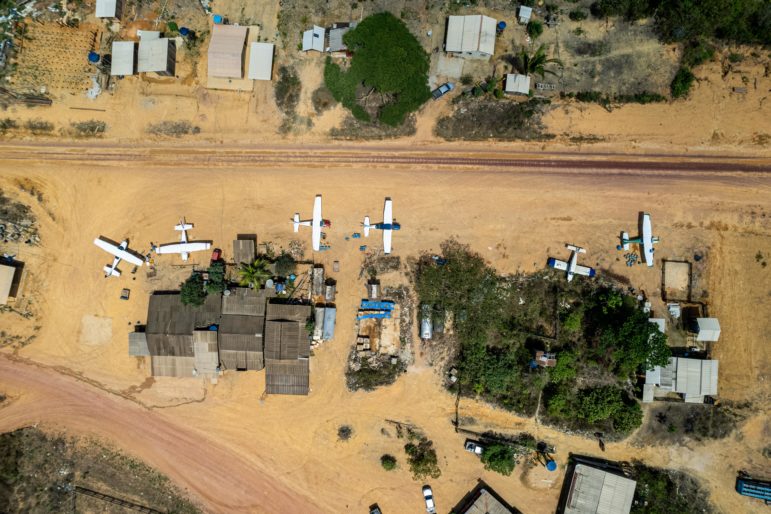

Image courtesy of ADEPA
Making and Breaking: A World Tour of Innovation and News Labs

Image: Courtesy ADEPA
There are no chemical formulas, no “Breaking Bad” hazmat suits, no gadgets to measure humidity and atmospheric pressure, and you do not have to go down to a creepy basement and avoid extreme security measures to find them.
What are these so-called “News Labs”? They are labs, sure, and, yes, they are all about news. They’re spaces for innovation, sometimes catalysts of cultural change, many times “survival mechanisms,” and on many other occasions, they are the path to look for a new business model. The believers think of them as a “philosophy.” For some, they are a “must,” and for others, the agnostic ones, something that was already underway and that was extended as a policy into the workflow of the very newsroom.
One thing that’s certain is that News Labs are packed with journalists, animators, editors, filmmakers, software developers, engineers, data scientists and many others. They share several focuses and goals that can be divided into categories that often overlap: There are those who are dedicated to advancing and experimenting with new technology; those who try to find new commercial initiatives; those who are in charge of journalists’ digital training in the newsroom; and, finally, those who seek the Holy Grail of storytelling — how to find new narratives that add value in an increasingly raw and competitive context.
The International “Beacons”
El Pais launched a laboratory in March 2018. “The Lab is a creative space meant for special projects that are difficult to develop within the day-to-day of the newsroom,” says Lab coordinator Patricia Gonsalvez, who also confesses: “The internet can be a news shredder.” Though still fairly new, according to Gonsalvez, the space seeks to become “a small place to think, and where to explore new formats that can (hopefully) become a part of the day-to-day of the newsroom.”
El País Lab has four editors, a designer, an HTML layout designer and a software developer. This team is in charge of the production of the newspaper’s innovation projects, but it can always count on “journalists, photographers, infographic designers or experts in social media from the newsroom.” So far, they have worked on 360 content, podcasts, gamifications, visualizations and Google AMP (Accelerated Mobile Pages) Stories formats. “Innovating is part of what we do in the newspaper. The Lab is just one more example of that,” Gonsalvez says.
The New York Times took a different path. After unveiling its “Innovation” report in 2014, which toured the world and described its weaknesses as well as the path to take in the digital race, it published the “2020 Report” (as it’s called internally) in early 2017, “Journalism That Stands Apart.” This report stems from another internal survey, which shows the changes tackled up to that point, the adoption of data and the metrics in its workflows, as well as the way forward in the immediate future.
“I’m part of the Digital Transition team,” says Charo Henriquez, Senior Editor of Digital Transition Strategy at the New York Times. “This team has been in our editorial office for some time, but last year it took on a different configuration from our 2020 Report. We are a group of journalists, led by our editor Kim Perry, with experience in audience research, tools and storytelling (digital narrative), who are positioned inside the newsroom to offer training, strategic and technical support to editors and reporters.”
One of The New York Times’ 2020 Report findings was that, in order to serve its digital audiences, one of the priorities had to be to expand the training team. “The mission is to develop a culture of collaboration and continuous learning in our newsroom,” Henriquez summarizes.
From the other side of things — the universe of digital natives — BuzzFeed is a case study of the flexibility and reaction speed that is needed today. With great fanfare, in 2015 it announced the release of its Open Lab for Journalism, Technology and the Arts, and at the end of 2017, decided to close it.
“We want to break shit, and build it back better than it was before,” BuzzFeed CEO Jonah Peretti wrote at the time. They experimented with sensors, drones, bots and videos with 3D technology, but then came to another conclusion: “It makes more sense to have engineers and hackers integrated directly into the newsroom, instead of having them in a lab,” Peretti explained in a memo to his company.
“It didn’t work; that’s why we closed it,” says Amanda Hickman, former Lab director. “It was a very special place. We worked on creative projects, exploring technology with editorial collaboration, for two years. People brought their ideas in, inspired by things they wanted to work on. I looked for projects that could be synchronized with the things that the newsroom was working on, and could mean a challenge. After two years of work in a contained space in San Francisco, it was very clear that what BuzzFeed needed was a creative intervention that would spread all over its newsroom: to find people with innovative profiles, and make them work within teams.”
It is well known that BuzzFeed is a creative and experimental space, but, for Hickman, the closing of the laboratory meant a loss: “The practice of documenting and publishing our findings, of publishing and sharing open source, that is something that does not happen anymore. We asked ourselves what we were trying to learn from an experiment, and we could look back and see what we had really learned. The learning, at times, was very far from what was intended. That is something that cannot be done outside of a laboratory. It is something that a newsroom cannot allow itself to do.”
What’s Happening in Argentina?
There are no “News Labs” here. If there ever were, they stopped existing to make way for a philosophy that pretends to be more open, and seeks to be transversal in organizations.
“At La Nación, innovation is installed as a creative process in all areas of the company, including the newsroom, and even in all overlapping projects,” says Gastón Roitberg, Digital Content Secretary. “It is not a specific department because we believe that it has to be a way of working that flows naturally in the newsroom, in sync with its different speeds. Each new project for us is a laboratory,” he says.
“We searched for talent that could focus on experimentation and innovation, creating teams with journalists and developers to make mobile products, 360 videos and virtual reality, and to experiment with gamification strategies to build service bots for the elections,” says Milena Zapata, General Producer of TN Digital, about Todo Noticias’ case. “Today, we are working with artificial intelligence to automate processes within the newsroom,” Zapata adds.
“The main challenge is to find new journalistic narratives that can add value for users, and improve the understanding of a story,” says Marcos Foglia, Director of Digital Platforms at Artear. “In order to develop new journalistic or entertainment narratives, it is necessary to create the appropriate context in advance. That’s why it’s important to radically modify the structure and culture of these organizations. Media companies are still designed under parameters that are closer to the printing press revolution and the subsequent rise of the graphic journalism industry than to the great technological revolution that we experienced in the last 20 years, with the arrival of the internet.”
According to Franco Piccato, Editor-in-Chief of La Voz del Interior, “It is essential to change media culture to accelerate innovation. The actual context is digital Darwinism — the one that best adapts survives.” Platforms such as Facebook, Instagram, YouTube, Twitter and Snapchat now have a central role in the distribution of content. “They challenge our monetization process. We need to innovate to create the future,” Piccato says.
Uno.com.ar, from Grupo América, works like a laboratory. “It is part of its essence,” says Ezequiel Apesteguía, Head of Product and Mobile Experiences. For him, labs are indispensable. “But they do not make sense if they are not fully integrated with the rest of the teams, from the generation of an idea to feedback after publication. Research and development teams are now something from the past,” he says.
They all agree that laboratories were, and still are, engines of change. “In the current context of traditional media, labs are a key tool in trying to build a culture that can assimilate changes. And that does not guarantee innovation, but it does make organizations better predisposed to innovate,” Apesteguía adds.
The Role of Platforms
In Argentina and the rest of the world, Google’s “contribution” to journalism comes in the shape of a lab. Google, the platform that concentrates the internet searches of the world, has been presenting itself for some time now as a training space for journalists in the digital universe.
“Google News Lab works with media, newsrooms, journalists and entrepreneurs to boost innovation and help journalists acquire new digital skills,” Juan Manuel Lucero, Google News Lab Lead in Argentina, explains. More than 100,000 journalists have already been trained in the world, and around 11,000 in Argentina. What are the topics? They are always linked to the interest of journalists and media: information visualization, advanced searches, security, digital trends and information verification.
Facebook did the same thing last year, and presented The Facebook Journalism Project. The initiative, which is not a lab per se, seeks to develop new products, train journalists around the world and fight against fake news. The platform hired Campbell Brown, a former CNN and NBC news host, to articulate better ties with media editors.
This announcement was later overshadowed by the Cambridge Analytica scandal, the data filtering that affected more than 87 million users, which represented losses in Facebook’s valuation in the stock market and summons to congresses and parliaments that ended up in headlines of the most important media organizations of the world. Even within this scenario, the digital giant (which sends a large percentage of its traffic to the media) sets the pace of innovation, and has developed tools and formats that frame and generate a new demand for storytelling.
“There is a great need for journalists to have training,” Lucero says. “There is enormous enthusiasm and interest in everything that allows them to understand new tools, conceptual tools, how to manage their resources better and establish more nimble work methods,” he adds.
The Academic Contribution
The Columbia University School of the Arts’ Digital Storytelling Lab explores future forms and functions of storytelling.
“When we say forms, we’re specifically referring to shifts in the ways people create and experience stories,” says Lab member Rachel Ginsberg. “Some examples of this might be the integration of emerging technologies, like AR/VR or AI, or developments in participatory and collaborative methods. Specifically, we research and design methodologies that can be used as prototypes for the use of storytelling as a design tool.”
Two of the Lab prototypes that have had great impact were the literary adaptations of “Sherlock Holmes and the Internet of Things” and “Frankenstein AI: A monster Made by Many,” two narratives with a collaborative approach that were presented, among several other places, at the Sundance Film Festival.
The academic approach has a clear focus point that media organizations are just beginning to discuss: the conversation.
“We’re specifically interested in generating ideas and works that push the direction of culture and technology as it’s developing. We strongly believe that the voice and needs of humanity need to have a seat at the table in that process. We always approach every possible project with a lens that aims towards creating a positive social impact and a cultural shift,” Ginsberg explains.
Lab or No Lab: A Permission to Make Mistakes
Ginsberg is convinced that laboratories are absolutely necessary in traditional media: “Today, as the status quo continues to crumble, and new paradigms emerge constantly, the development of an environment that is not afraid to experiment, which can withstand and navigate ambiguity, is essential.”
In a mobile world, within a context of “digital Darwinism” in the midst of the challenge for “survival,” and in the winding way to find alternative business models, labs seem to be the answer for many, a “must-have” for others, and an already-outdated model for those who are more skeptical.
“Innovation requires a culture that emphasizes saying ‘yes’, which prioritizes action over deliberation,” says Piccato from La Voz del Interior.
“Are we training future journalists and content producers who measure up to the technological revolution that has forever changed content production and consumption?” asks Marcos Foglia from Artear. “Do we have the organizational charts, processes, work culture and roles to train and retain the best talent?”
Lab projects require certain things that seem impossible to accomplish in the day-to-day of a newsroom: teamwork, collaboration, long-term objectives, autonomy, freedom of action and permission to make mistakes. But behind this search for different types of laboratories, or different approaches inside of newsroom teams, there is only one thing that continues to prevail: journalism, the craft of reporting.
“Will the simplicity of stories for WhatsApp, or the super-productions of augmented reality and immersive journalism triumph? Both? I don’t know. I imagine that it will be necessary to go down the path of trial and error, with creativity, daring and, above all, with good journalism,” says Gonsalvez from El País.
Henriquez, from The New York Times, agrees: “We have to focus on good journalism, on the main skills of reporting, writing and editing. Tools are learned; platforms evolve and change constantly. The biggest investment should be in the quality of journalism, and in helping journalists think about their audience in multiple ways.”
It is important to tell all kinds of stories, in different ways, across all platforms. But there is something that should be put on the table: “We must recognize the financial pressure of media organizations that perceive this as a race they have to win,” says Ginsberg of Columbia University’s Digital Storytelling Lab.
Buzzfeed’s Hickman is on the same path: “There is a preconception, or desire, that it will be possible to subsidize the editorial staff from the ‘inside’, from the newsroom, but I think it is something that will be difficult to achieve.”
As Isaac Asimov said: “No sensible decision can be made any longer without taking into account not only the world as it is, but the world as it will be.” Innovation is a leap of faith. It’s Indiana Jones crossing the invisible bridge to reach the Holy Grail. We already know that the world has become mobile. With or without a lab, it’s time to take risks, make mistakes and focus on what media knows best: good journalism.
This article first appeared in Spanish in ADEPA’s yearbook and is reproduced here with permission.
 Juan Ignacio Sixto is a journalist, teacher and digital storytelling researcher from Argentina. He spent the past 10 years in digital news, focused on mobile and cross-platform innovation initiatives at Clarín Group. He now works with Viacom’s Americas Digital Studios International. He also collaborates with Argentina’s News Entities Association to research media and the pace of innovation.
Juan Ignacio Sixto is a journalist, teacher and digital storytelling researcher from Argentina. He spent the past 10 years in digital news, focused on mobile and cross-platform innovation initiatives at Clarín Group. He now works with Viacom’s Americas Digital Studios International. He also collaborates with Argentina’s News Entities Association to research media and the pace of innovation.









